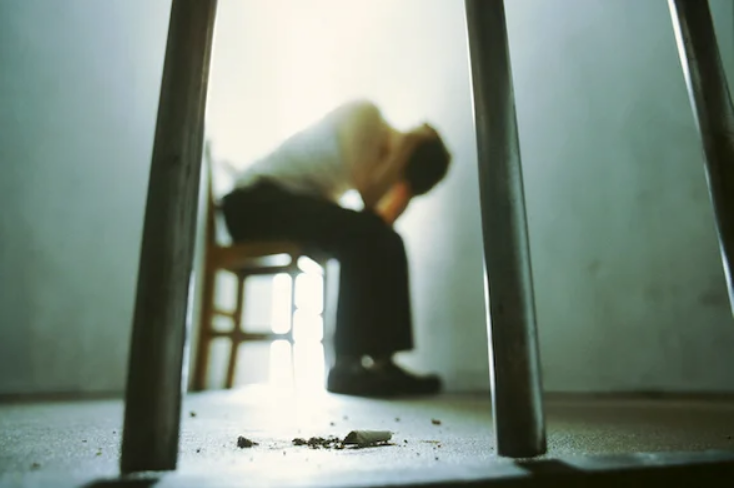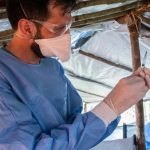Science can help society grapple with the horrors of modern gun violence

I gave a gift to a man who is about to be killed. He agrees that he should be killed, because he murdered innocent people, but he regrets. Regret wells in the wake of senseless violence rocking American society today. That emotion permeates this dark period of horrific mass shootings and daily violence, and it reveals a path to prevention.
I opened the envelope and read the words typed out on cheap newsprint paper, destined to yellow and decay.
“I am an inmate here on Death Row. I have had trouble with my anger all my life….”
The typewriter’s worn ribbon left each letter fading toward the bottom, as if the lines were vanishing. I imagine the prison scene and the sound of typewriter keys slapping under the fingertips of a solitary man taking this action in the last days of his life—not for redemption, but for prevention.
The letter reads, “I had committed [the crimes] in a fit of anger while I had been up for days using Meth. I am not using this as an excuse for what I did.”
A quick internet search disgorged a revolting record depicting a horribly cruel path of destruction. In a fit of rage, this man brutally shot and killed his wife, her young son and an innocent young woman whom he took as hostage in a getaway attempt.
“I am guilty and right where I should be,” he wrote.
The Boston Bomber now regrets what he did and the pain and suffering he caused to his innocent victims and their loved ones. The Aurora theater shooter regrets. The D.C. sniper regrets. The teen-age shooter who killed 17 people in a Florida school regrets. Regret in the aftermath of such horror is obscene. Obscene because that nauseating emotion rising in the aftermath of the bloodbath means that the catastrophes need not have happened. The regret conveys the obvious: no one in their right mind does such things.
The death row inmate wrote to say that something I had written had helped him understand how his life derailed. If he had read this material on the neuroscience of violence earlier in his life, he wrote, “I might not be here today.”
Feeling somewhat conflicted, I put a package in the mail addressed to a correctional facility in another state, directed to the attention of an inmate identified by a number. It was a signed copy of what I had written, which the man said had helped him, and that he wished to share with others in prison.
The name “correctional facility” is accurate from society’s perspective, but it is a delusional euphemism from the perspective of most inmates. According to the National Institute of Justice, three quarters of prisoners will be rearrested within five years of their release. We lock up 7.16 out of 1,000 people in the United States, the highest rate of incarceration in the world. With only 5 percent of the world’s population, the United States has 25 percent of the world’s prison population. Why?
We read the waves of horrible news reporting brutal violence, click our tongues in disgust and despair; and we turn the page, something the victims of violence can never do. The explosion of senseless mass violence in places that were once society’s most cherished communal places, schools, concert stadiums, public transportation and even houses of worship, is ripping apart the social fabric of American life. According to the Washington Post, 214,000 boys and girls have been subjected to shootings in their schools, and 141 children and educators killed since the Columbine High School shooting in 1999. The median age of school shooters is 16 years old. This is a new type of violence. It is violence by males alienated and angered by their perceived lot.
Each mass shooting sets spinning another round of debate over legislation, but the answers to the modern scourge of violence in America cannot be found by looking only at laws. If someone wants to go into a school with a gun, or to run over people on the sidewalk, or to brutally murder their spouse, nothing can stop them. The roots of violence at the level of brain biology need to be understood so that violence can be prevented.
Researchers have found a high incidence of genetic factors that increase impulsivity and anger in the violent prison population, and also an increased incidence of neurological abnormalities detectable with brain imaging. Studies of twins show that heredity accounts for over 60 percent of the risk for aggression.
There are powerful environmental factors too. “I was raised by my father who was a Marine corps drill [sergeant] and my whole life was taught to be tough and never take any crap from anyone but also to not show any of my emotions so that no one could use that against me,” the inmate wrote, looking back from Death Row to the roots of his violent rage.
Violent offenders are predominantly from lower socioeconomic class. Half of the prison population is addicted to drugs, and drugs and alcohol are involved in 80 percent of violent crimes leading to incarceration. The mentally ill are no more likely to be violent than anyone else, but data show that they are more likely to become violent when abusing drugs. A new study finds that exposure to certain adverse events in early life, while the brain is undergoing maturation, greatly multiplies the odds of being institutionalized as an adult for violent aggression. They include poverty, social rejection from peer groups, cannabis and alcohol abuse, living in an urban environment, traumatic brain injury, immigration, conflict and violence in the home, and physical or sexual abuse. One of these factors alone does not increase the risk of violent aggression measurably, but they add up, compounding the risk that a child exposed to multiple adverse factors will become a violent adult.
The perpetrators of violent crime are almost always male; 93.1 percent of the prison population is male. Males of many species, certainly so for primates and humans, have evolved through the survival-of-the-fittest struggle in the wild, brain and bodily attributes that equip and predispose them to engage in aggression to provide and protect. This biological drive in males for aggression still exists in modern civilization. When something goes bump in the night, who is it that goes, or is expected to go, armed with a baseball bat or some other weapon, to confront the intruder? It is not that males are more courageous or selfless than females; they are not. It is that males are five inches taller and 30 pounds heavier on average than females. Biology.
Male violence erupts from interpersonal disputes, in response to disrespect, in assaulting women or protecting them, from being jilted, bullied or from being a bully, from becoming enraged; from ending up the loser in an environment that necessarily creates winners and losers; from the need to get theirs, even if it means taking it from others, and to battle threats to the tribe.
Male biological propensity for aggression is a double-edged sword; indeed, peaceful co-existence in society depends on it. Six policemen were wounded rushing into the massacre at the synagogue in Pittsburgh last week to rescue terrorized victims and stop a hate-filled gunman in a life-or-death battle: Timothy Matson, Daniel Mead, Anthony Burke, Michael Smidga, John Persin and Tyler Pashel. Males comprise 87 percent of the police force in the United States. However, many of the societal mechanisms that controlled and channeled male aggression productively in the past are weakening. Belief in religion has been declining in the United States, Europe, and the U.K. for years, with 23 percent of Americans now expressing no religious affiliation. Youth participation in organized sports is declining. Even the Boy Scouts, now rebranded “Scouts,” is no longer only for boys.
The changes in society and in traditional male roles must be accompanied by new approaches to channel male aggression positively. From the perspective of the man on death row, this can be reached by a path guided by neuroscience. Schools must bring this increased understanding of the biology of aggression into the classroom and teach mechanisms of anger and impulse control. The signs of alienation and brewing rage, especially in young males, that lead to drug abuse and violence must be recognized and acted upon promptly with understanding, psychological intervention, and education to prevent regret. It is of no use if this insight comes on death row. Males have this biology of aggression for a reason, but it must be adapted to our current environment.
The day after the school shooting at Parkland, Florida, I received a frantic call from my daughter in nursing school in another state. She was crying and shaking in terror. There was a gunman on campus and the school had been put on lockdown. She and her 30 classmates huddled together on the floor in the back of the classroom. My daughter and others cradled two young women in their arms, who were incapacitated by terror, shaking violently and weeping uncontrollably. As high school students the two girls had been survivors of Columbine. They were reliving a nightmare of the worst day of their life, but for all the students the utter helplessness they felt as they waited to have their life taken left nothing but terror. Two nursing students took charge.
Prior to this the two had attracted little attention because they were quiet and reserved, and possibly because they were among the few males in the class. Drawing on previous experience in the military and police, something none of their classmates had known about them, they told the others where to hide because the bullets would go right through the door, and that there was nothing in the room strong enough to block the entrance. Then the two men braced their backs hard against the door and waited.
The late Christian Garcia, a 15-year-old boy in Santa Fe High School, did the same thing. Nine of his schoolmates had their lives taken by a boy on a rampage with a gun. Christian gave his.











RSS